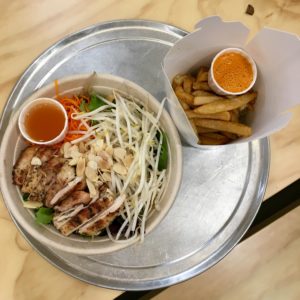
An antiquated, demeaning term describing the sexual fetishization of Asian women has no place in one of the country’s largest grocery store chains.
Ta-Nehisi Coates had a good riff during a talk at a suburban Chicago high school about the use of the n-word in the black community and why non-blacks shouldn’t use it. Essentially, he reasoned, words have both meaning and context. What a given word means coming from the mouth of one person can have a much different meaning than the same word coming from the mouth of someone else—depending on the context and the relationship between the people conversing. For instance, my name is Lucas, and my mom sometimes calls me Lukie. If, say, a new dentist I was trying out did that during a cleaning, that would be a little odd.
On April 25, a new Whole Foods 365 opened in Long Beach, California, that features, among other things, an Asian-fusion restaurant called Yellow Fever. I’ll admit that when I first got wind of this, it smelled like a trap. It was too far out there, too patently offensive, even for as racially clueless a society as ours sometimes is. For Whole Foods to have a restaurant called Yellow Fever—a skeevy and antiquated epithet that describes the exoticizing and sexual fetishizing of Asian women (and men)—seemed oddly tasteless at best, blatantly racist at worst. Then came the plot twist: The owner, Kelly Kim, is a Korean-American woman. She began the business, a fast-casual restaurant selling customizable Asian bowls, four and a half years ago in nearby Torrance and thinks it’s high time to reclaim the term.
And that complicates the matter considerably.
Kim, as an Asian-American, can make the argument that she has the right to publicly use words or phrases that may be demeaning coming from the mouths of non-Asians. But does all hurtful and marginalizing language demand to be reclaimed? And more to the point, does that right extend to the business partner, Amazon/Whole Foods, one of the most powerful and far-reaching brands in the country?
Thinking about Kim’s restaurant, I considered my own history: I’m Chinese-American and, growing up in mostly white suburban Chicago, was frequently the target of racist cracks about yellow skin and slanted eyes. With ties to the Chinese Exclusion Act of the late 19th century, the phrase “yellow fever” evokes the “faceless, nameless yellow horde” and xenophobia described by historian John Dower in his 1986 book War Without Mercy. It’s a term that still conjures embarrassment and shame for many Asian and Asian-American women in the country. “For me, it’s a mocking, dehumanizing phrase guys online send to me,” writes Dakota Kim. Racial fetishes frequently depend on stereotypes—in this case, the idea of delicate, servile Asian women. Yellow fever has even been weaponized by white nationalists, who hold up the stereotype of subservient Asian women as a sort of utopian, anti-feminist ideal.
But it’s not just Nazis. The ooze of yellow fever slides into the DMs of countless Asian women daily; it’s ingrained in the multibillion-dollar sex-tourism industry that plagues Southeast Asia; it’s found in the lyrics of Weezer’s 1996 song “El Scorcho” (otherwise a jam, I’ll grant you), which declares creepily that half-Japanese girls “do it to” frontman Rivers Cuomo every time. The result is one of homogenization and oppression, propagating the view that all Asian women are the same and then placing the onus of conforming, or resisting, those stereotypes upon those very women, further adding to their burden.
The term “yellow fever” is rooted in racism, but that’s not the question. It is, rather, what happens when Kim sets out to reclaim that term in, as she says in an interview on the website Nextshark, a “kind of shocking” manner? No one person is the arbiter of language. But as an Asian-American, I could be convinced that under certain circumstances, “yellow fever” falls under the category of acceptable usage. Just as Chinese friends might make “Oriental” jokes amongst themselves, or a Filipino drag queen named Yellow Fever would certainly garner my adulation, Kim could (and indeed has, for several years) make a plausible claim on the term.
But Whole Foods cannot. Whole Foods, owned by the largest Internet retailer on earth and with nearly 500 locations and 100,000 employees, has no right to the language that Asians, who are frequently left out of the racial discourse in America, have permission to use within their own community. Whole Foods, with a long history as a harbinger of gentrification in major American cities, has not come close to earning that privilege. And by partnering with Kim’s restaurant, they’re simply sneaking in through the back door.
A big part of the problem involves the word “normalization”—a word you’ve doubtless heard since Kanye West’s embrace of the #MAGA movement last week and nonstop since the presidential election two Novembers ago. The power and reach of Whole Foods is unmatched among grocery stores in this country. By plastering “YELLOW FEVER” on one of its ubiquitous stores, there’s a strong message being sent to the public: This deeply problematic phrase is OK. This deeply problematic phrase can be used without fear of reproach. This is normal.
The ooze of yellow fever slides into the DMs of countless Asian women daily.
“I’m Asian, and I’m fine with the name” is the gist of some comments on social media and news articles about Kim’s concept. (Reached for comment, Yellow Fever sent me a boilerplate statement and their media kit, which reads in part, under the branding section, “‘Words don’t offend, people do.’ Words are empowered by action and Yellow Fever’s actions will always be positive and represented by good food and good deeds.”) Which is a completely acceptable opinion: You do you. But it doesn’t excuse the hurt and bafflement others may feel and should not be used as justification to normalize the phrase. Non-Asians should not feel free to use that language under the false impression that it’s benign and isn’t rooted in pernicious stereotypes. And while Kim may have the right to reclaim that term for herself, she cannot push that onto others who are unwilling to do so. And that, unfortunately, is the result of her partnership with a brand as ubiquitous and powerful as Whole Foods.
Isn’t this punishing her for her success? I don’t view it that way. She comes across as quite savvy and, in at least one social media post, seems to have seen this storm coming. Moreover, the exponential increase in exposure that a Whole Foods partnership provides demands something in return: greater responsibility and forethought in matters like these. But I have no desire to bash Kim: I place most of the blame with Whole Foods. How no one within that finely tuned PR machine, the entire time this partnership was running up the corporate flagpole, put on the brakes and forced a name change is utterly confounding.
The name, for me, really is the only barrier between that place developing a relationship with my wallet. Because—ready for another plot twist?—the food isn’t bad. For a fast-casual Asian concept, it’s actually quite good. I went one evening last week, sat in what resembles a bright yellow shipping container, and ate a “Saigon” bowl (other options included Seoul, Shanghai, and Bangkok) of well-seasoned grilled chicken on a bed of greens that was perfectly decent, as well as fries served with a legitimately tasty gochujang dipping sauce.
“Anyong!” the menu greets you in Korean. “Itadakimasu!” it exclaims in Japanese in nearly the same breath: “Let’s eat!” Is the mashing together of different Asian languages and cultures bothersome? Sure—as much as any Asian-fusion place or mention of an “Asian chicken salad” on a restaurant menu—but that quickly becomes a pick-your-battles scenario. The slow march to the emergence of an Asian version of Chipotle seems inevitable (ShopHouse, the literal Asian version of Chipotle, recently closed all its locations, leaving a vacuum for something that’s quick and isn’t Panda Express). And I would frankly prefer that the concept come from an Asian-American woman like Kim than most other scenarios.
But I can’t get behind the name. A quick web search of “orientalism” and “exoticism” yields pages of information on how the otherization of peoples (depicting someone as foreign, or different) through a Western European, white-centric lens is so harmful. PC zealotry is not the goal here: Communities can and should work through pain and history by reclaiming language. But that’s a right that is earned. Simply handing that language over to a large corporation, to be monetized and used by the general public, including those who created the harmful language in the first place, is a step backward. Let’s put the phrase “yellow fever” in a museum, where it belongs: to be observed and, hopefully, learned from. I’d happily sit down with Kim sometime to brainstorm new names.
Photo illustration by Alexandra Citrin-Safadi

